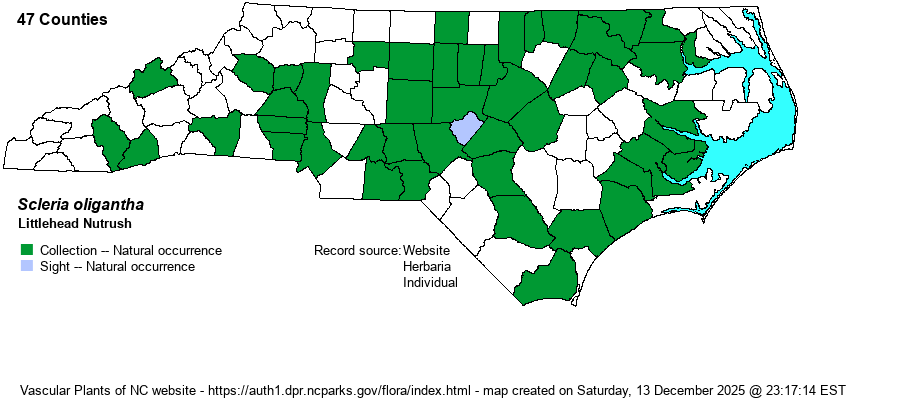| Author | Michaux | |
| Distribution | Throughout most of the state; scarce in the northeastern corner and in the Mountains. Gaps in the Piedmont are artificial (unless absent in the far northwest), but gaps in the Coastal Plain are probably real.
NJ to MO and OK, south to central FL and TX; Mex., Guat., Hond. | |
| Abundance | Common in the eastern half of the Piedmont; uncommon in the Coastal Plain and much of the western Piedmont; rare in the Mountains and in the far eastern and northeastern areas. The wide range of the species in the state strongly suggests that this is an S5 species. | |
| Habitat | Dry to mesic upland hardwoods, mixed woods and forests, wooded glades, occasionally moister habitats. Soils vary from acidic to alkaline, but apparently with elevated minerals or nutrients -- but never in strongly acidic soils. | |
| Phenology | Flowering and fruiting June-September. | |
| Identification | This is a perennial species, very leafy, and a "clump-former". The leaves radiate outward and parallel to the ground, with the leaf tips bending down to touch the ground. The flowering stems stand erect or lean over, 1-2 feet long and red-purple at the base. The inflorescence clusters are small, with only 1-4 spikelets each. The seeds have 8-9 rounded tubercles at the base, rather than 3-6 tubercles in some other nutrushes. | |
| Taxonomic Comments | None
The genus Scleria, named as nutrushes, is a group of sedges notable for the white, often glossy, achenes (seeds) and tough, knotty, horizontal rhizomes (absent in S. verticillata, S. muehlenbergii, and S. reticularis). Stems are 1-many per plant, terminated by inflorescences of 1-several spikelets, subtended by leafy bracts. In some species there are also inflorescences produced from upper and middle stem leaf axils, these usually on long arching stalks. A dissecting scope is necessary to examine the achene for shape, ornamentation (bumps, pits, ridges), and hairs. Just as important are features of the hypogonium, upon which the achene tightly sits: present or not, how many lobes, and ornamentation (bumps, sharp points, etc.). | |
| Other Common Name(s) | Few-flower Nutrush | |
| State Rank | S4 [S5] | |
| Global Rank | G5 | |
| State Status | | |
| US Status | | |
| USACE-agcp | FAC link |
| USACE-emp | FACU link |

